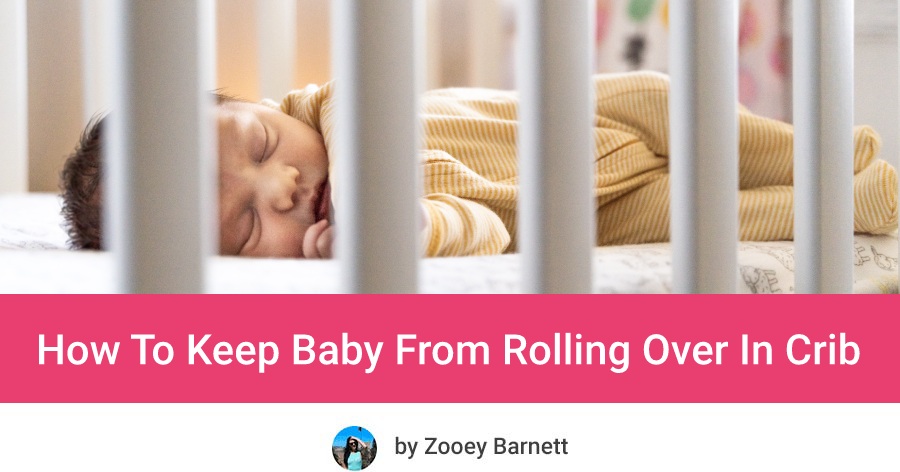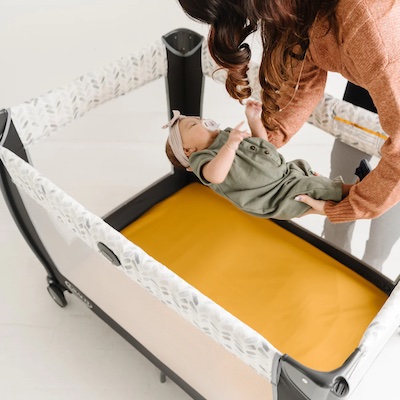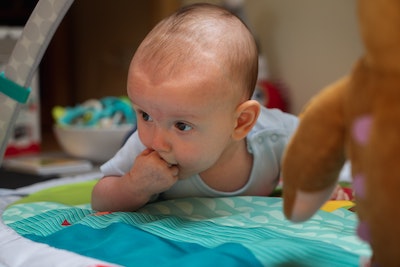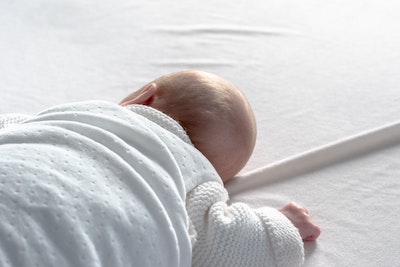For new parents this may be quite scary if their baby keeps rolling onto their stomach. We all know that sleeping on tummy increases the risk of SIDS that’s why it’s so important to create safety sleep space for the baby. Keep on reading to find out how to keep your baby from rolling over in crib.

Like any good mom, you may be concerned about your baby’s safety at all times, even while sleeping. And really, sleep time is probably the only non-supervised time your newborn has, isn’t it?
During baby’s sleep, it is advised that you put your baby to sleep on his back. However, your baby may roll over onto their stomach while sleeping, and this presents a host of questions: Should you move them (will that make them awake?!)? What if your baby rolls in their sleep? Is tummy sleeping safe? Should you use pillows or wedge to prevent babies rolling?
So, this post is all about safe infant sleep and what to do if your baby is rolling in their bassinet or crib.
This article is not a substitute for medical advice.
Why Does My Baby Roll Onto Their Stomach While Sleeping?
Once your baby rolls over while awake, and they have learned this new skill, you will likely see them rolling over frequently, even in their sleep. However, it is possible for them to roll from their bak to their belly before they really have developed this skill (consciously).
So why do they do they roll over? Probably to get comfortable, much like me or you. Babies usually prefer snuggling on an adult’s chest, that adorable position with bums in the air, and lying on their belly during sleep provides a similar position.
What Is The Safest Sleep Position?
Make “back to sleep” your mantra for baby sleep during the first year of your child’s life.
This means that you should put your baby down to sleep on their back until they are one year old.
Why Back To Sleep?
The “Back to Sleep” Campaign was started by the American Academy of Pediatrics, which recommends healthy term infants sleep on their back to reduce the risk of sleep-related infant deaths and reduce risks of sudden infant death syndrome (SIDS)1.
Studies and reports showed that infants who were placed to sleep on their back (supine) were less likely to die from SIDS than those placed to sleep on their stomachs.
Now, if you’ve ever wondered if stomach sleeping is really a risk? Or if your baby rolls onto stomach while sleeping but can’t roll back, can you just leave them? Then please, read on.
If you’re a new mom, please know this isn’t said to scare you, but rather to empower you. Don’t be scared, but do be informed.
You can reduce the risk of SIDS simply by establishing good sleep habits like “Back to Sleep” and ensuring a safe sleep environment for your little one.
Next, let’s consider if your baby rolls from back to tummy on their own and what precautions to take to protect your baby.

When Do Babies Start Rolling?
Reaching this milestone is slightly different for each and every baby, but you can expect your child to do a full, independent roll between 3 and 4 months of age.
However, many babies learn to roll earlier than this, so don’t be surprised if you see your baby rolling before 3 months.
The Importance Of Tummy Time
From day 1, you can begin practicing tummy time with your infant to help them develop neck and head control. Place baby on a clean (non toxic) play mat or other firm, soft surface, or even your own chest and observe them lift their head for a few seconds at a time.
This exercise is vital, because once your baby is able to lift their own head and turn it from side to side they will be much safer, even if they roll over while in bed.
Tummy Time Tips
- Many parents practice by placing their newborns on their chest, as a bonding and skin contact at the same time.
- Do when baby is awake, but not immediately after a feed (the position will push on their full stomach).
- It is okay if your baby is crying or seems uncomfortable. Don’t panic: it’s only a minute or two and it will help your baby develop the necessary muscles for proper development and reach important milestones.
- Always have supervised tummy time with young babies.
As the weeks go on, your baby should have more frequent and longer tummy time “exercise sessions” to build up their muscles.
You might not see baby rolling for several weeks (or months!) yet, but they are getting stronger, and may even be doing little “push-ups” as they lift their head and shoulders off the ground for a few seconds at a time.
This is how, after practice, they will learn to roll.

How Do Babies Roll At First?
It is common for babies to roll from tummy to back when they first start rolling, because rolling from back to tummy requires more neck and core strength to master this new skill.
Your baby starts rolling over for the first time they may be a bit surprised or startled, as it is a new position they have never experienced before. It shouldn’t be scary for your baby, but cheer them on and clap or smile for them.
When they have developed neck muscles and core strength, you’re likely to see a baby roll in bed (or on any firm, flat surface).
Can I Prevent My Baby Rolling During Sleep?
The straight forward answer is NO.
While you may have placed your baby to sleep on their back, it is common for an infant to roll onto their stomach during sleep, even if you don’t notice baby is rolling during tummy time just yet.
You should NOT prevent your baby rolling with pillows or object (such as wedges or stuffed animals) these are a suffocation hazard.
Reduce the risk of suffocation or SIDS by ensuring your baby’s sleep surface is void of loose bedding, blankets and crib bumpers.
In short, no, you cannot prevent your baby from rolling during sleep.
Is It OK If Baby Rolls Onto Stomach When Sleeping?
Some babies roll in their sleep, it’s just the reality (hey! plenty of adults do, too!).
You can’t really sleep train to stop it, and no matter what position they fall asleep in, they may roll onto their stomach a few nights every week.
The best approach is to encourage tummy time and help them to learn to roll so they can move their head and breathe, not have their face smashed into the mattress.
If your baby, who is, say 6 months old, is already confidently rolling and they aren’t awake, then it can be safe to leave your baby sleeping on their stomach and let them wake naturally after their nap
However, if your baby is a newborn (especially if they are swaddled), under 8 weeks old and not able to roll over on their mattress yet, it is best to return them to their back, even if it means their sleep may be disturbed. Read more on how to stop baby from sleeping face down in this article.

What Do You Do When Baby Rolls Over In Crib?
If your baby is swaddled with their arms tucked in, you must turn them back over to their back2.
How To Roll Back A Sleeping Baby
Returning a baby to their back doesn’t not mean you have to pick them up out of their crib and risk waking them entirely.
You can do this gently, without picking them up or even lifting them off the mattress.
Just lay one arm flat against their side and, with one hand at their head (to offer support to the neck), and the other around their core, roll them over. You can softly turn their head to one side, and adjust the arms to be natural and comfortable.
Do you always have to move a sleeping baby off their tummy?
I would suggest that a young baby who hasn’t shown the ability to “push up” and breathe during tummy time should be returned to their back, even if it disrupts babies sleep, because of safety risks.
However, if you have a baby rolling confidently and frequently, then it can be acceptable to let them continue stomach sleeping.
This is especially true the closer a baby is to their first birthday. An eight-month old baby, who has good neck muscles and is is able to turn their head and roll over is much less at risk than a newborn infant for suffocation if their face is pressed against a mattress. The eight month old will almost always be able to turn their head or push up and reposition themselves.
Remember: if your baby rolls, then it’s time to stop swaddling and transition to a sleep sack or warm pajamas, instead.
If your baby’s sleep area is safe (no loose blankets), then you have a lot less too worry about if baby rolls over during sleep, too.
What If My Baby Gets Stuck On Their Tummy?
When baby starts rolling, the first few times they may get ‘stuck’ on their tummy. As long as they can lift up their head and cry, then you shouldn’t be concerned – just go an lift them up and cuddle them because being “stuck” can be scary for a baby.

How To Prevent Baby From Rolling Over In Crib
The answer here is very straightforward: you cannot safely prevent a baby from rolling over in the crib.
Positioners or wedges that advertise to prevent babies from rolling in their sleep could be dangerous and lead to suffocation. Please do not use these to prevent baby rolling.
Instead, emphasize safety in your baby’s crib first and foremost:
- No stuffed animals, toys or soft objects in the crib
- A firm mattress with a well-fitting crib sheet
- No loose blankets in the crib
- Use a video monitor with night vision to check on your sleeping baby as often as you like!
Ensuring a safe infant sleeping environment can really prevent sleepless nights of worry and constantly checking on your baby.
Here you can also check out my list of safe and best mini cribs for small spaces that are perfect for newborns, but also grow with the child throughout toddlerhood.
Stop Swaddling
As soon as your baby starts rolling (or even attempts some practice rolling) stop swaddling during naps or bedtime.
When your baby can roll is the time to transition to a baby sleep sack instead of a swaddle.
A sleep sack also allows for a bit more movement of the legs, which may result in more rolling, unfortunately.
However, if you keep practicing rolling, they might be able to roll back after a few weeks. They will need the use of both their arms and legs to accomplish that, so a sleep sack is the ideal option for your rolling baby.
How To Keep Baby Safe During Sleep
The best way to ensure your baby’s sleeping space is safe and reduce your baby’s risk of sudden infant death syndrome (SIDS) to to follow safe sleep guidelines posted by the American Pediatrics: a safe sleep environment and safe sleep practices.
Also, the American Academy of Pediatrics advises parents to sleep in the same room as their newborn for the first six months of life. This could be with a baby bassinet attached to your bed, or the baby’s crib stationed in the corner of the parent’s bedroom.
- Remember, it is not safe to sleep with your baby in the same bed as Mom and Dad (co-sleeping), your baby should have their own sleeping space.
- A swaddled baby may sleep better, as the feeling mimics the position in the womb. It is safe to swaddle young babies, but you should stop using a swaddle as soon as baby begins rolling over, even if they have never rolled in their sleep before.
- Even the safest crib mattress can be dangerous if you have loose bedding or positioners in the crib.
Why Is Back Sleeping Safer?
There is a lower risk of SIDS when babies are placed to sleep on their back in the crib.
Newborns don’t have a strong neck just yet and moving their heads can take a lot of effort. This means that if your baby’s face is pressed against the crib mattress and they cannot move their head, it could inhibit their breathing or even potentially cause suffocation.

When Do Babies Begin Rolling Over?
Every baby is different, but the average time babies reach this milestone is around 3-4 months old. You can help your baby roll by practicing tummy time consistently (always during awake time).
How Long Does The Rolling In Crib Phase Last?
Some adults roll around in their sleep, and we’ve all heard the stories of how toddlers “take up the whole bed”. This goes to show that in some cases, the “phase” doesn’t ever really end. Some people continue moving in their sleep.
Are Sleep Sacks Safe For Babies Who Can Roll Over?
Sleep sacks keep baby’s arms free, they can use their arm muscles to push up and may be able to roll back to sleep, even return to their back, (roll from tummy to back).
A swaddled baby, with their arms against their sides, is not able to push with their arms, which makes it harder to breathe if their face is against the crib mattress and increases the risk of suffocation.
What If My Baby Will Only Sleep On Their Stomach?
Since we’re talking about potentially an impact on your baby’s life, we have to be serious here. Even if your little snuggler may be a better “tummy sleeper” when they fall asleep on your chest or in the carrier, it is important that you lay them down supline.
When To Speak To A Doctor
Rolling over is a developmental milestone most babies reach around 4 months of age. Some babies are earlier, others a bit later.
However, it isn’t the only milestone your pediatrician will consider: he or she will look at healthy development, eye contact, interaction with caregivers, movements of arms and legs, as well.
While you should practice tummy time and look for signs of rolling, don’t worry too much if your baby doesn’t roll at 4 months of age. It’s perfectly normal for some babies to learn this new skill later.
If you have concerns about your baby’s development, especially if you feel that they are not developing adequate neck control by five moths, despite regular tummy time, talk to your pediatrician.
The purpose of this article is informative. It’s not a substitute for professional medical advice or medical care. Remember: safety first! Consult your doctor/pediatrician in case of any doubts. The author of this article does not accept any responsibility for any liability, loss or risk, personal or otherwise, incurred as a consequence, directly or indirectly, from any information or advice contained here.
Resources:
https://www.healthline.com/health/baby/baby-rolling-over-in-sleep
https://www.webmd.com/baby/what-to-do-if-your-baby-is-rolling-over-in-the-crib
https://www.medicalnewstoday.com/articles/baby-rolling-over-in-sleep
https://www.newtonbaby.com/blogs/hush/baby-rolling-over-in-crib
https://www.nestedbean.com/blogs/zen-blog/baby-rolls-over-in-sleep
https://safesleeptech.com/baby-rolling-over-everything-you-need-to-know/

